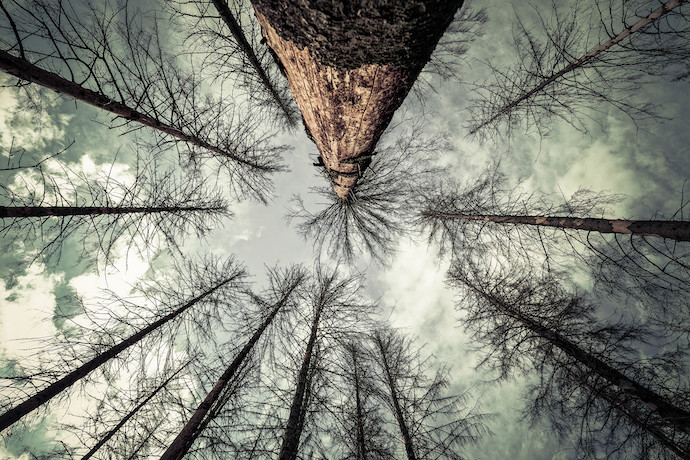When writing as critical scholars of religion about the impacts and role of religion in society we need to broaden our remit, and must do so quickly. Let me explain why.
It’s probably best to start with environmental history, thus the name for this dispatch. It’s a riff on the geographer Clarence Glacken’s magisterial 1967 opus with the completely accessible title, Traces on the Rhodian Shore: Nature and Culture in Western Thought from Ancient Times to the End of the Eighteenth Century. The book is similarly dry, but oh so full of important facts and syntheses of Western (and of course, sadly, male) intellectual thought about interactions between humans and nature. Glacken condenses 2000 years of Western thought about nature to three themes, the third of which I’m interested in here: “the idea of man [sic] as a geographic agent.”
First, let’s jump ahead to data points about human impact on the natural world that Glacken didn’t have in 1967. These updated data points will overly determine everything in society moving forward, including how humans produce religion and thus how we academically study, research, and teach about it. They’re also data points published in just the last two months, bridging 2020 into 2021. Trends suggest future data points will only be more alarming and more severe, but we’ll get to that.
1. 2020 is tied with 2016 as the warmest year in recorded history. Sadly, if warming trends triggered by human addiction to fossil fuels and other practices that release heat trapping greenhouse gasses continue (spoiler: they will), then 2020 will be downright cool compared to how hot it’s going to be in 2040 and 2050 and, well, basically for the rest of the foreseeable future. The possibility of more rapid warming in the coming decades is very real, too. This is because the oceans are becoming saturated with excess heat which will remain in the atmosphere once they’re fully saturated. It’s also because at some point in the future permafrost will start thawing and releasing methane. Sound alarming? Not when we get to data point number 2.
2. Basically, we are not alarmed enough. Not by a long shot. Rather, in concluding their analysis of climate data, an international group of scientists write, “We have summarized predictions of a ghastly future of mass extinction, declining health, and climate-disruption upheavals (including looming massive migrations) and resource conflicts this century…we contend that only a realistic appreciation of the colossal challenges facing the international community might allow it to chart a less-ravaged future.” I’ll return to this point later. For those wanting another piece about the need to avert collapse with rapid interventions, here you go; and here’s another from a scholar who has opined we’re past that point and need to talk about deep adaptation. But I digress.
3. Human-induced global warming (with vast past and present intersectional differences in complicity and power within this) has led to the Earth losing 28 trillion tons of ice from the Arctic sea and ice shelves; mountain glaciers; Greenland (the statistical odds are increasing that this melt will radically slow or even stop the Gulf Stream); and Antarctic sea and ice shelves. That’s a lot of water. And the rate of melt is only going to increase. The rate also tracks closely to worst-case sea-level- rise predictions from the most recent IPCC report for ice sheets, suggesting a minimum 16 inches of sea level rise by 2100 from just this one source, with more to come after that. (For those of you employed at campuses or institutions near the coast, like I am, this should be adding to feelings of alarm.)
4. Another group of scientists are very worried that the Earth will soon lose its ability to capture (or “sink”) carbon out of the atmosphere due to oversaturation that will then lead to structurally impoverished ecosystems. Their fear is that by 2040 (the freshmen we’ll be teaching then are being born right now) the ability of land to be a carbon sink will be halved, severely amplifying global warming feedback loops.
5. The cultural stories and values we have about the worth and role of nature, matter. How we discuss the natural world across social science and humanistic disciplines, matter, as seen here in the undervaluing of nature in economics.
Most of the rest of my argument builds on data point number 5, focusing on how religious studies (as if that’s a monolithic thing) to date has talked about the natural world. I share the below as someone who is at the core of my training a religionist who’s vested in using education to build a better, more sustainable society. I recognize that understanding the role of religion in society is of import as we work toward this goal and that we should indeed be talking about racial justice, religious liberty, and sex/gender/justice as articulated by Religion Dispatches and its various contributors.
But notice, here, that nature/ecology is not a central concern—either of religious studies or RD. This is a microcosm of larger trajectories in the historical development of religious studies where expertise in the study of religion and nature/ecology is frustratingly underrepresented by tenured positions in most all academic departments of religion, as well. Yet we are precisely at a time when we need religious studies to help shape both the environmental humanities and sustainability in higher education. This is a concern I have with the field, especially given the first 4 data points above.
We know that disciplines are as much a social construction as is the academy itself. This suggests that education on a much warmer planet is going to shift in the years and decades to come towards addressing and responding to data points like those above. Will the humanities have a place at the new academic table on a planet going through biome shifts? And will religious studies and its methods and theories about religious and non-religious/secular actors and communities the world over—all of whom will be adapting to climate change—have a seat?
I think here of the adaptive cycle of resilience and how the academy, similar to fossil-fuel driven civilization as a whole, is going to be moving from conservation to a far more radical reorganization. If those in religious studies want to be present in a reorganized academy, then those teaching and researching religious studies will likely have to be of worth to societies grappling with averting collapse and, at least according to the data points above, adapting to what appears to be the very real possibility of runaway climate change. This means centering across our discipline and in our departments the natural world. And we must do so in a way that emphasizes justice, racial and otherwise.
There are movements within religious studies that point towards helping with such a reorganization. I think here of the religion and nature program at the University of Florida, the only Ph.D. program of its kind and from where I earned my Ph.D. (go Gators!). I think, too, of the Yale Forum on Religion and Ecology, as well as the International Society for the Study of Religion, Nature, and Culture. In theology I think of, for example, Drew Theological School; but I also think of the very real pushback from some of the more conservative (read: white evangelical) schools of theology and the approaches of their traditions to understanding the natural world that may be anathema to navigating adaptation and promoting any type of non-anthropocentric cultural values ascribed to the planet. And despite these programs being early adopters of a religion and nature/ecology approach to religious studies, they’re still outliers, massively outnumbered by the majority of programs that do not teach such courses (or possibly offer a token elective course on religion and nature/ecology) or train scholars to teach and research such content.
The above data points, all published in the last two months, strongly suggest that Glacken’s analysis was spot on: we are geographic, and thus geologic, agents to the point of now triggering shifts in ecosystems to new biological and chemical structures that will unfold in our lifetime and in those of our future students. These regimes will be hard to adapt to and will most likely inform very different human ways of being religious in the decades to come. How we understand these shifts and situate ourselves as scholars of religion studying them is a matter of increasing import, if for no other reason than that it may impact the relevancy of our field as higher education reorganizes itself.
I mention all this because part of the human reorganization within climate shifts will include the funding of higher education. We already see religious studies being targeted during economic crunches triggered by demographic contraction. The post-Covid economic landscape is also still to emerge, but I do think the humanities, and within it religious studies, will take most of the 2020s to recover, if they do at all. It is very possible that those departments and programs in the academy not teaching to the above data points may be of even less value to administrators and the paying public by the 2030s and 2040s.
This is especially salient as students at that time will be looking for programs and classes that speak to acquiring skills and understanding how to adapt to and make sense of climate change. The ethical, normative, historical, and analytical skills that religious studies offer should indeed (and, I argue, must) be part of this future. However if many of those in religious studies are not systematically foregrounding and speaking to religion and nature/ecology interactions, let alone within the context of climate change, then we shouldn’t be surprised to have our programs of study lose funding and import and the interest of students in the decades to come.
This brings me back to data point 2. If we think of future dispatches about religion written from inundated shores, hopefully they will reflect that religious studies joined with the rest of the academy in rising to the colossal challenges of our time. Hopefully they will reflect new hiring patterns, new patterns of engagement with colleagues across the academy and, in our teaching and research, a foregrounding of the natural world upon which our survival, let alone our intersectional flourishing, entirely depends.





